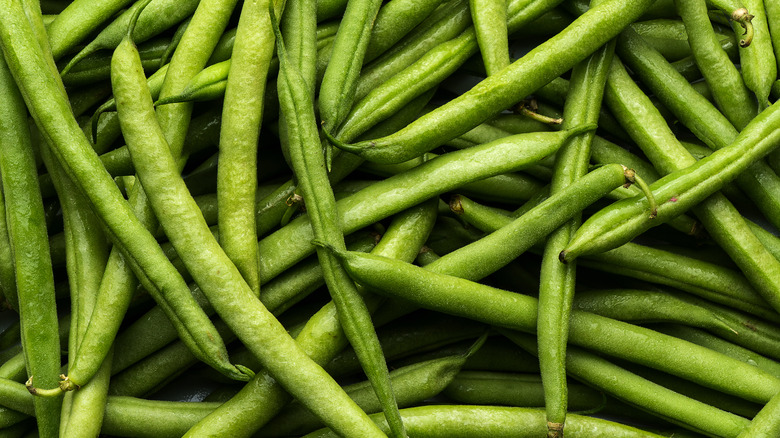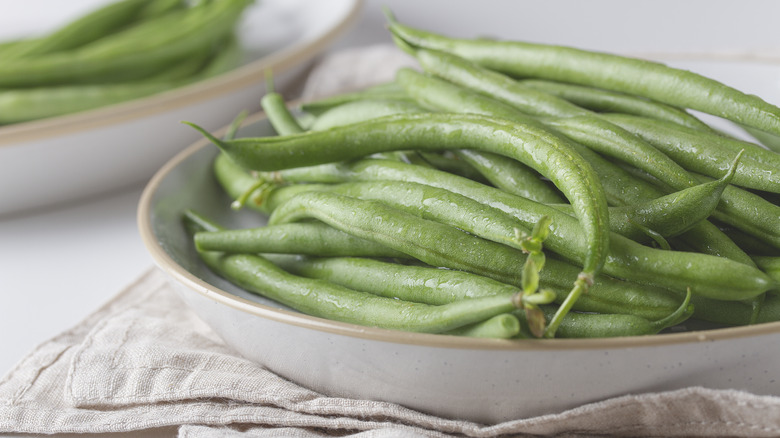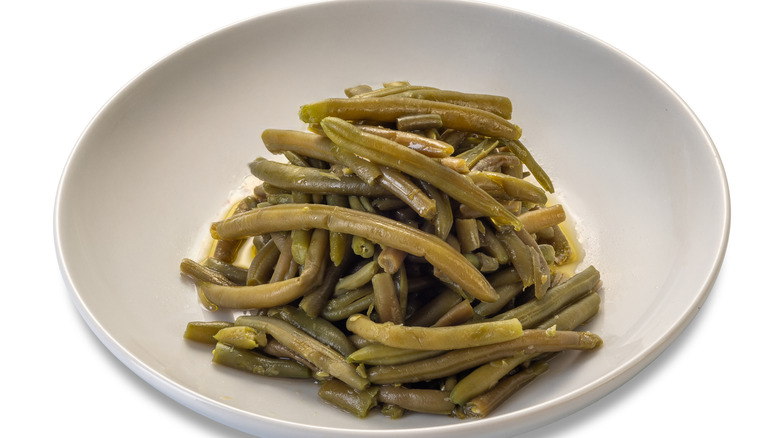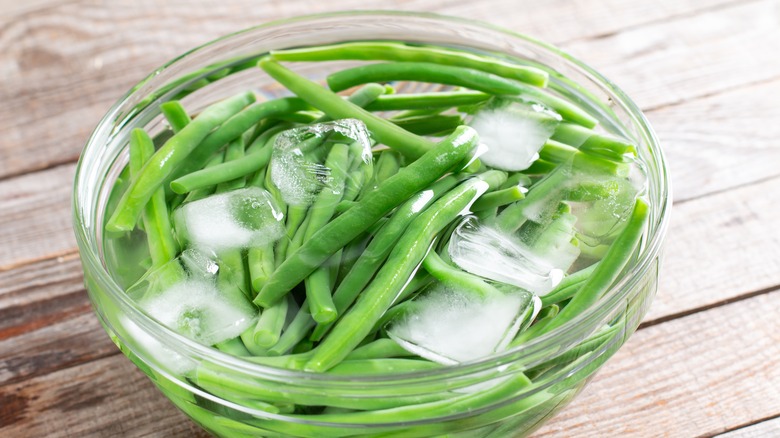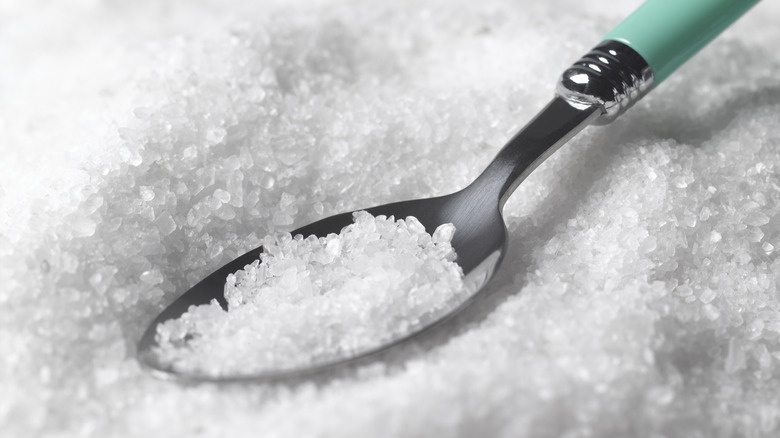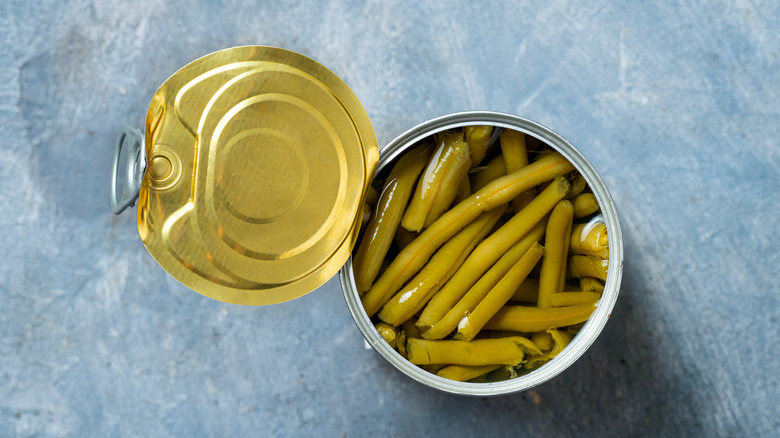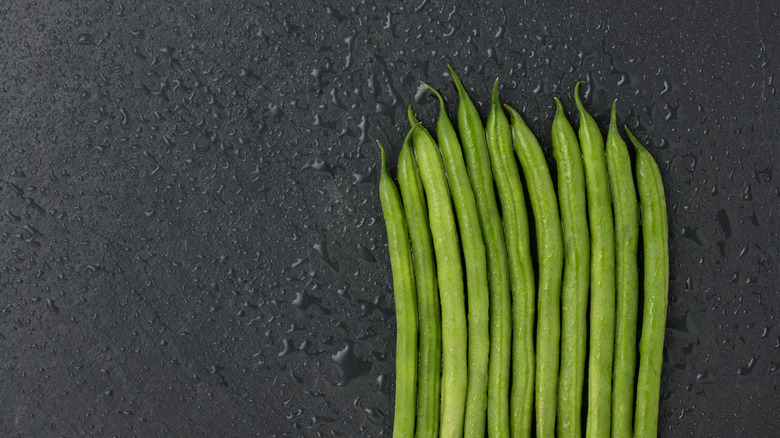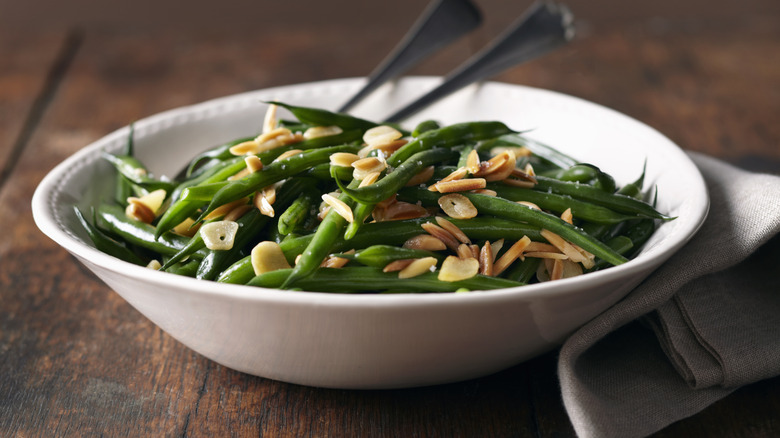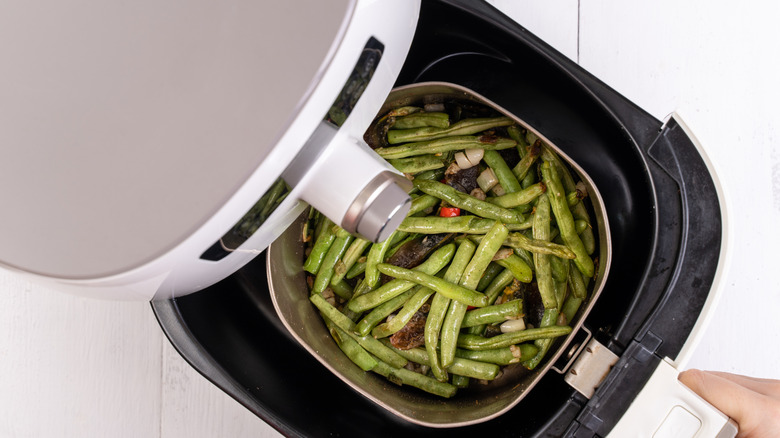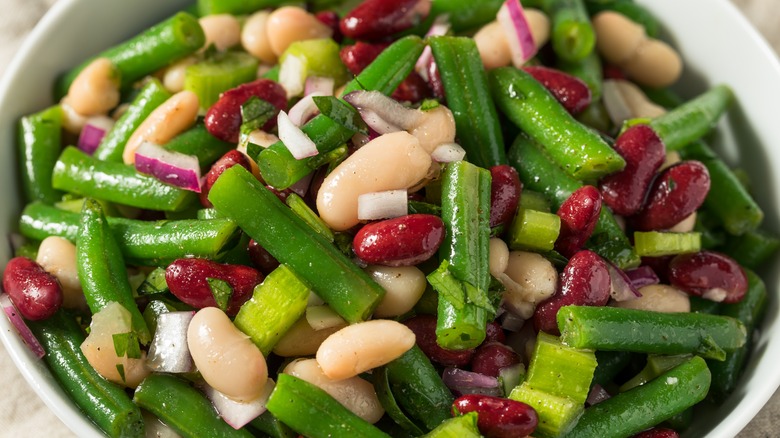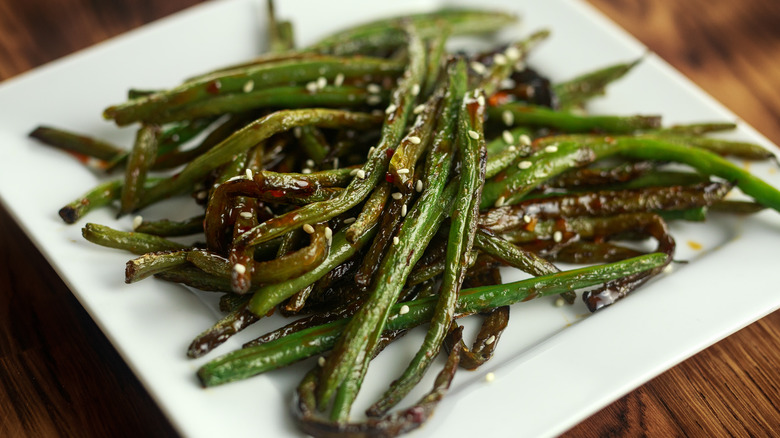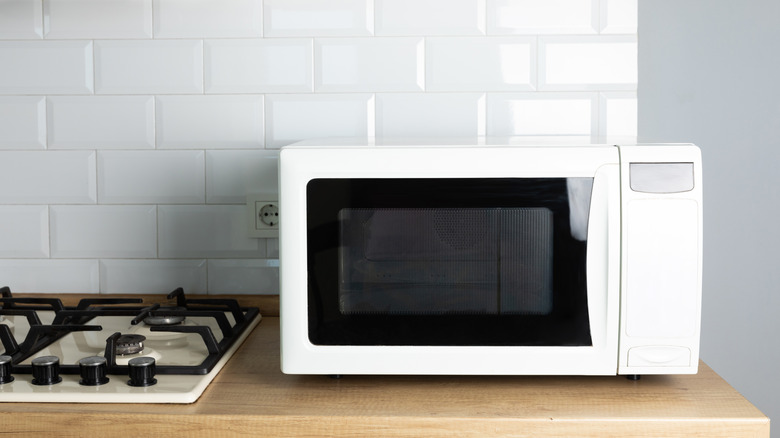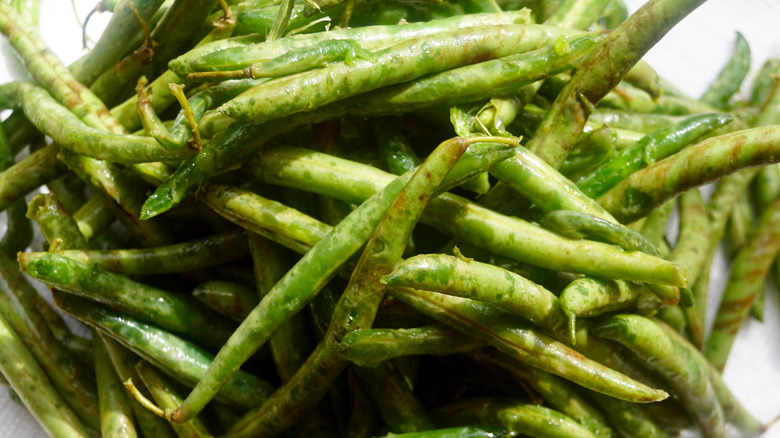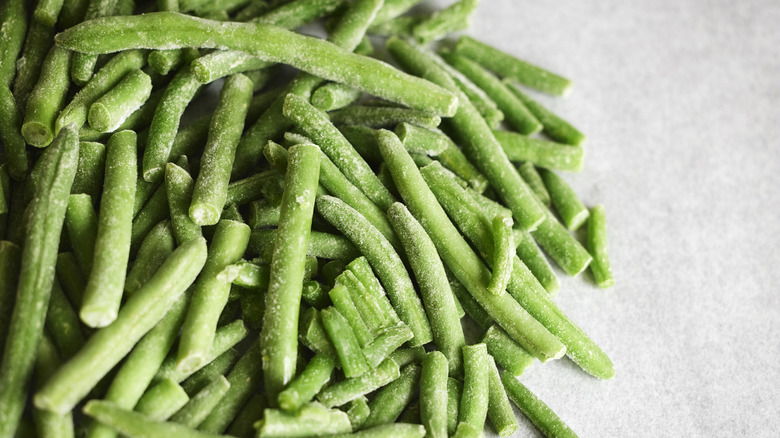13 Simple Mistakes Too Many People Make When Cooking Green Beans
Green beans should be simple to cook, right? These simple vegetables seem pretty much ready to go from the moment you get them home, and after a couple of minutes in boiling water, you can have a delicious and nutritious side dish that's full of B vitamins and fiber. That's the ideal scenario, anyway: The truth is a bit more complicated than that. Green beans may look easy to cook, but the reality is that this unassuming veggie can be a minefield to make. These beans can be surprisingly complicated to prepare, and to make them taste good there's a surprising amount of work involved. That's all after you pick the right beans to start with, which can be a bit more difficult than it looks.
Green beans are also one of those vegetables that goes from crisp and crunchy to soggy and soft in a matter of seconds, and failing to get your timings right can ruin them very quickly. Perhaps the biggest mistake people make, though, is boiling them in the first place and missing the rich world of opportunities available with these beans. With our help, you'll never get your green beans wrong again.
1. Mistake: Picking the wrong beans to start with
If you don't buy green beans on a regular basis, you may not know exactly what to look for. This uncertainty can lead a lot of people to buy beans that are either past their prime or not quite ripe enough, which results in a substandard flavor and texture when you come to cook them. It's therefore vital to get familiar with what fresh green beans look like, to ensure that you don't end up with a batch that you can't use.
Fresh green beans will be firm to the touch and have a tiny bit of give in them, but they aren't overly bendy or pliable. There should be no bulges across each bean, and they should have a vibrant green color to them. If the beans look like they're torn or damaged in any way, that may not be a sign that they're not fresh, but it's definitely a clue that they've been handled poorly and may be susceptible to spoiling faster. Make sure you're assessing each bean separately — especially if you're buying a big pack of them — so that you don't end up with a bunch of beans where half of them aren't up to scratch.
2. Mistake: Boiling your beans for too long
It's fair to say that most vegetables are pretty gross when they've been boiled for too long — but green beans might be the grossest of them all. When you boil green beans longer than you need to, they develop a squidgy, waterlogged texture. The fibers in the beans soften, but some of them remain taut and stringy, resulting in a two-tone consistency that leaves bits of beans in your teeth. They also lose any of their fresh flavor, and end up tasting of grass-flavored water.
Luckily, the fix to all of these issues is simple: Just take your green beans off the boil earlier than you think. Green beans generally take no longer than 4 to 6 minutes to cook through when boiled. Any more than that, and they'll start to get soggy. The amount of time you need can depend on how you prepare and slice your beans: If you've chopped them into smaller pieces, you may want to err towards a shorter time. You should also bear in mind that the residual heat from the boiling water will continue to gently cook them once they're done, so drain them completely and serve them as soon as possible.
3. Mistake: Forgetting to blanch your beans
If you're not blanching your green beans, you're missing out. Blanching your beans helps to keep their crunchy texture and vibrant color without overcooking them. When you blanch green beans, you submerge them in boiling water for just a few minutes before pulling them out and immediately popping them in an ice bath. The quick boil intensifies their color and partly cooks them, while still retaining their crisp texture and earthy flavor. Shocking them with ice water also halts the cooking process, ensuring that they don't continue to cook on your plate.
Blanching green beans is also an essential step if you're planning on freezing them. When you blanch your beans, you stop the enzyme activity which causes them to degrade as they sit in the freezer, ensuring that they remain crunchy and fresh-tasting. It's worth mentioning that blanched beans won't be for everyone, and if you're cooking for kids it may be smarter to boil them all the way through so they can chew through them properly. For folks who want a little something to get their teeth around, though, it's the best way to go.
4. Mistake: Not adding salt to your beans
When you're serving vegetables as a side dish, they can often be cruelly neglected on the flavor front. Way too often, people will pile their just-cooked green beans next to their meal and forget to consider that they need something to brighten them up a bit. The thing they need the most is salt, folks. Chef and author of "The Plant-Based Diabetes Cookbook" Jackie Newgent told Foodie that with green beans, you really need "the addition of salt — generally at the end of cooking — to get the most full-flavored experience." A sprinkling of salt helps to highlight the nutty flavors in the beans, pick up their subtle savoriness, and give them a little extra crunch to complement their inherent crispiness.
A pinch of sea salt isn't your only option here, too. Newgent points out that a dash of soy sauce or coconut aminos can give green beans a pop of sodium without disrupting their natural texture. Just make sure you're not adding too much salt to your beans, as over-seasoning your vegetables can ruin their nutritious nature.
5. Mistake: Opting for canned green beans over fresh ones
There are good canned veggies, and there are bad ones. We don't mean bad in terms of them being bad for you (although some of them are way less healthy than you might think), but we mean in terms of them just not tasting that great. Unfortunately, this is the case with canned green beans, which can become horribly mushy once they're canned. They also lose their bright green color once they've been sitting in a can for a while, and instead turn gray and sickly-looking. Plus, canned green beans tend to develop a slightly metallic taste, with the flavor note dominating any former freshness they once had.
As for that healthiness we mentioned earlier? It's definitely worth keeping in mind. The nutritional differences between canned and fresh green beans can be pretty minimal in some areas, with much of their vitamin and mineral content remaining the same or similar. However, canned green beans can have a wildly high amount of sodium per serving. Some of the most famous brands out there, like Del Monte, plow almost 300 milligrams of sodium into every half-cup of canned green beans. When you combine that with their substandard taste and texture, they're just not worth it.
6. Mistake: Not trimming your beans
Green beans are one of those vegetables that's easy to ruin — and all it takes is forgetting to do one key thing. A lot of people fail to remove the stem end of the green bean, which is the part that has a slightly knobby end and a tough, stringy bit hanging out of it. Instead, they throw their beans in without any preparation whatsoever, and then are disappointed when they can't chew their way through it, and end up with a chalky mouthful of fibrous vegetable matter.
All of this can be avoided by giving your green beans a quick slice before cooking them. Line your beans up by pressing a bunch of them against your hand at the stem end, and then slice them all off using a sharp knife, so that you don't crush the beans. Try to aim as close to the ends of the beans as possible to avoid cutting too much of the actual flesh off. Once they're removed, cook them as quickly as you can to avoid the ends drying out and shriveling up. While a lot of folks think you have to chop off the tail end of the beans too, the only reason to do so is if you want them to look a little more uniform. That end is entirely edible, so you don't have to remove them if you don't want to.
7. Mistake: Forgetting to add extra ingredients
Green beans can be great, but let's be real, people: Everything's better when you add a few extra ingredients. Green beans are one of those veggies that's incredibly well-suited to a range of flavors, and whether you're roasting, boiling, or frying them, you're going to want to make sure you're doing what you can to make them as tasty as possible.
If time is at a premium and you don't have anything in the fridge, simply adding some butter and a scrunch of pepper to your green beans can work wonders. The creamy notes from the butter add a luxurious flavor to the beans, while the pepper delivers a touch of piquancy that pairs well with their nuttiness. If you want to lean into their fresher flavor dimensions, adding lemon and walnuts to green beans is a great option. A spritz of lemon juice helps to brighten up the beans, with the walnuts giving them a warm crunch.
These are really just starting points, though — you can add pretty much anything to your beans. Sauté them in some garlic, drizzle them in some balsamic glaze, or douse them in a paprika-infused oil. The choice is yours!
8. Mistake: Not using your air fryer to cook green beans
The firm, crunchy texture of green beans doesn't have to be softened when you cook them. Instead, it can be amped up even further in the air fryer. Cooking your green beans in the air fryer can leave you with a crispy snack that you'll be chomping down by the fistful while feeling the wholesome glow of munching on something healthy. When you cook green beans in the air fryer, they quickly brown and crisp up on their exterior while softening gently on the inside, turning them almost into a healthier version of a french fry.
To get super-crispy air-fried green beans, aim to cook them for around 12-15 minutes in the air fryer at 375 degrees Fahrenheit. Remember to check them every few minutes or so, as you don't want them to burn here, and all air fryers cook food at different speeds. Don't forget to season your green beans either, to give them maximum flavor. Plus, don't be tempted to try and cook them without any oil. While air fryers are renowned for being able to produce crispy food without the fat required to deep-fry items, your beans will still need a small amount to stop them from burning.
9. Mistake: Only cooking your beans for hot meals
Green beans are generally served steaming hot and piled high on a serving dish, ready to be forked onto your plate. While there's nothing wrong with this serving style, a lot of people forget that this isn't the only way to eat the vegetable. Green beans are just as good cold as they are warm, and they're excellent as the base ingredient in a salad. Their tubular shape means that any dressing you add to them works its way right to the core of the vegetable, giving them a huge amount of flavor — and they go especially well with tart flavors, like goat cheese dressings.
When you're serving green beans cold, though, there are a few things to think about. The first is how well you cook them. You may want to blanch or roast them, instead of just boiling them, so that they retain a firm texture while still having a little give and providing a fresh crunchiness to your plate. Cold, overcooked beans really don't hit the spot here. Plus, give your beans a little bit of time to sit in whatever dressing you're using, to allow them to really absorb every flavor going on.
10. Mistake: Forgetting to cover your beans when cooking them
Cooking green beans seems simple: You just introduce them to a heat source, wait for them to soften, and then serve them, right? Well, not quite. When you're cooking green beans, you really need to cover them. "The slower you cook the green bean, the more the chlorophyll in the green bean degrades and you lose the greenness of the bean," Chef Tris Revill explained to Foodie. No matter how you're cooking them, if you fail to cover them, heat escapes more quickly, which lengthens the cooking process and allows them to turn gray.
So, clamp that lid down on your beans, people. If you're frying them this can of course be tricky, but try to put the lid on your pan in between tossing or stirring them. Crucially, you'll need to account for the increased heat when covering your beans, too. Closed pots of boiling water can bubble over very quickly if you're not careful, so make sure you're turning your heat down slightly to avoid this.
11. Mistake: Not microwaving your green beans
When cooking green beans, your microwave is your best friend. A lot of people feel tentative around using the microwave to cook green beans (or, indeed, any vegetable) because there's a fear that doing so can leave you with a mushy end product. However, when you time things right and prepare correctly, you can produce a tender result every time while flavoring your green beans in the process.
The key to getting perfect green beans in the microwave is covering them, first with a small amount of water and then with a lid on your microwave-safe bowl or container. Doing this will protect the beans from the direct action of the electromagnetic waves in the microwave, and will instead allow them to steam, giving you a vibrant dish at the end of it all. It's also a good idea to add some fat to your beans, both for flavor and to stop them from sticking to your pan (or each other). We'd recommend popping a knob of butter in with your beans and the water. Oh, and don't forget to dice up some garlic and throw it in too — as the beans steam, they'll take on its deep, aromatic flavors.
12. Mistake: Using green beans that have gone bad
It's something that's happened to all of us: You buy some vegetables, forget to use them when you thought they would, and then they sit at the back of your crisper drawer for the next few weeks. Then, when you finally remember that you need to use them, they look just a little bit past their prime — but hey, what's the worst that can happen? Well, with green beans, this can result in you eating vegetables that are at best unpleasant, and at worst could make you sick. As such, you should try to get familiar with the signs that your green beans have gone bad.
When green beans begin to spoil, they turn from firm to soft and limp. They can also begin to develop brown spots or patches of mold which disrupt their uniform green surface. While fresh green beans are smooth to the touch, spoiled green beans can start to feel a little tacky and slimy. What you might notice most, though, is the smell. Spoiled green beans will start to develop a sour, foul, almost ammonia-like scent that clearly flags that you shouldn't be eating them.
13. Mistake: Not using frozen green beans
As a general rule of thumb, when it comes to green beans, fresh is usually best. However, if you can't get your hands on any fresh green beans, frozen green beans are a great substitute. A lot of people look down on frozen green beans, but the truth is that they can deliver just as much nutrition and just as much flavor as fresh ones. When they're cooked properly, they remain tender and crisp, and you don't even have to worry about trimming them: Just open the bag, pour them into a pot of water or onto a baking sheet, and you're good to go.
It's also useful to remember that frozen vegetables are just as easy to upgrade as fresh ones, and green beans are no exception. Try stir-frying your frozen green beans with some other veggies and a bold chili-garlic sauce. Alternatively, roast them with some fiery spices and some grated ginger. If you just want to boost your regular meals with a bit of extra nutrition, pop them in a beef stew or stir them into a frittata. The best part? You don't have to thaw them to do any of these things.
Static Media owns and operates Daily Meal and Foodie.
